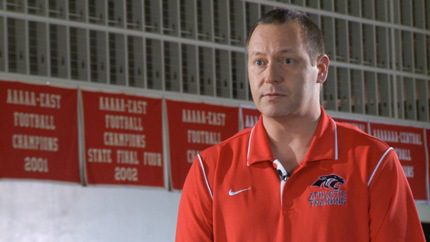
09 Mar 2016 AETN explores concussions in ‘Bell Ringer’ on April 7
The Arkansas Educational Television Network (AETN) will premiere “Bell Ringer: The Invisible Brain Injury,” a one-hour film exploring concussions, at 7 p.m. Thursday, April 7. A panel discussion will follow the program at 8 p.m. in “Arkansans Ask: Concussions.”
According to the Centers for Disease Control and Prevention, as many as 3.8 million brain injuries occur in athletics every year – and these are more common among children and students than star athletes. Through interviews with former professional athletes, medical experts and renowned researchers, “Bell Ringer” describes the short-term effects and long-term risks of concussions, explaining how to handle them when they occur and the best methods of preventing them altogether.
“We often hear about concussions in professional football, but they can be a problem in any sport, at any age,” said AETN Executive Director Allen Weatherly. “AETN produces programs like ‘Bell Ringer’ to help inform Arkansas educators, students and families and positively impact health and safety in our state.”
AETN produced “Bell Ringer” in response to The Arkansas Concussion Protocol Act of 2013, as well as Act 1214 of 2011, which requires coaches to complete training on concussions.
“We have to all work together to identify those scenarios and situations that can be dangerous to student athletes,” said Joey Walters, deputy director of the Arkansas Activities Association. “With a concussion, the most important thing is when you suspect that you’ve had some kind of trauma, that’s when you need to have attention.
“Just the suspicion of having a concussion, [athletes] should not return [to the sport] until evaluated, because that’s how serious it is. You cannot ignore concussions; you cannot ignore the effect they have on students.”
Featured in the film are:
• Michelle Akers, two-time World Cup champion and FIFA Female Player of the Century, U.S. Women’s National Soccer Team.
• Monte Coleman, three-time Super Bowl champion, head football coach for the University of Arkansas at Pine Bluff.
• Dr. Robert Abraham, neurosurgeon, NEA Baptist Memorial Hospital.
• Dave Halstead, co-founder and technical director, Southern Impact Research Center.
• Christy Rasico, mother of Zack Towers of Star City who died after a traumatic brain injury.
• Ty Towers, brother of Zack Towers, who recently finished his senior season on the Ouachita Baptist University football team.
• Tom Talavage, Ph.D., professor of biomedical engineering, Purdue University.
• Mike Oliver, executive director, National Operating Committee on Standards for Athletic Equipment.
• Jason Cates, head athletic trainer, Cabot Public School District.
• Chad Williams, certified athletic trainer, North Little Rock High School.
• Terry DeWitt, Ph.D., president, Arkansas Athletic Trainers’ Association, and athletic training coordinator, Ouachita Baptist University.
• Billy Elmore, Heads Up Football master trainer and head football coach, West Memphis High School.
• Joey Walters, deputy director, Arkansas Activities Association.
“Arkansans Ask: Concussions” will follow “Bell Ringer” at 8 p.m. April 7. Viewers may submit questions and comments at 800.662.2386, [email protected] or on Twitter with #ARAsk.
Filming of “Bell Ringer” took place at Ouachita Baptist University, the University of Arkansas at Pine Bluff, the University of Central Arkansas, North Little Rock High School, Hall High School, West Memphis High School and Cabot High School. The film was produced by Justin Blake Crum of AETN.
Additional information, including a toolkit for safely navigating brain injuries, is available at aetn.org/bellringer.
“Bell Ringer” will be available for online professional development credit for Arkansas state licensed educators via ArkansasIDEAS (ideas.aetn.org). Currently available to educators is “The Xs and Os of Sports-Related Concussion: Fact vs. Fiction,” which features Dr. R. J. Elbin examining the effects of concussion on an athlete as a whole, as well as the primary and secondary risk factors that relate to concussion risk and recovery.










